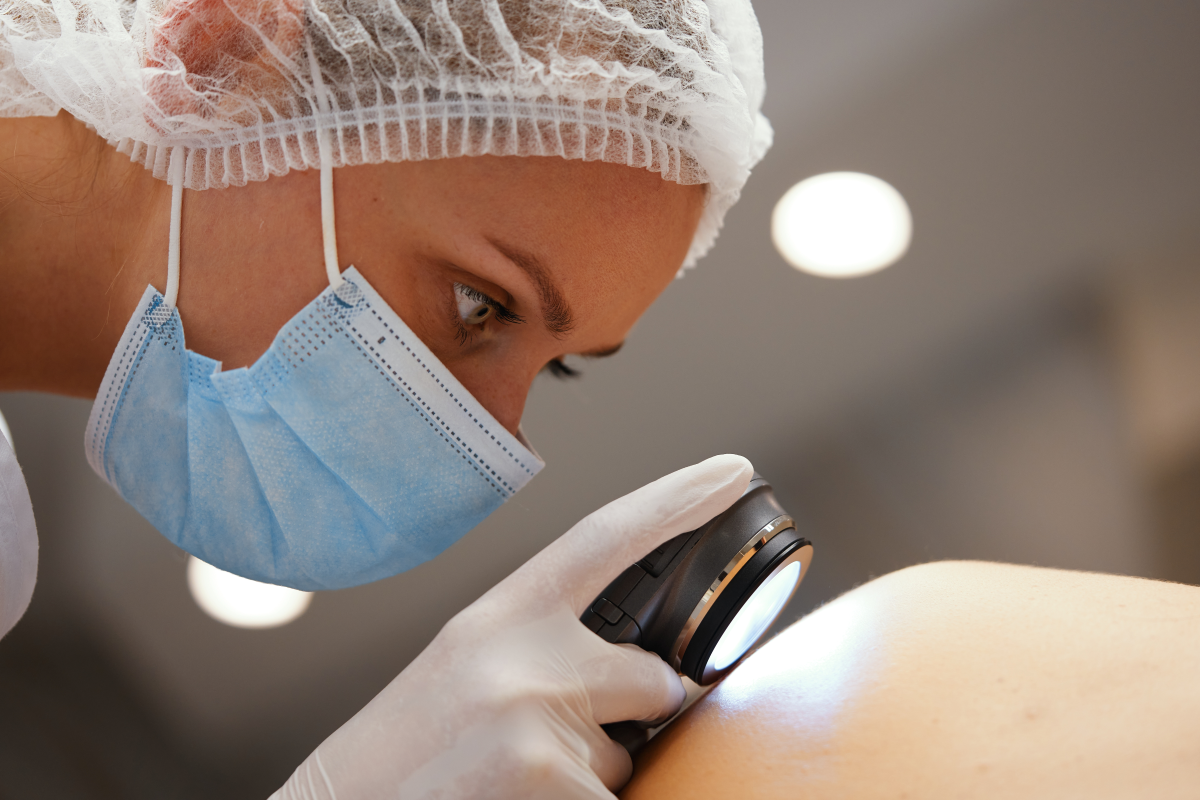Moles are common non-cancerous (benign) skin growths. Most people develop one or more at some point in their lives. While many moles are harmless, it is important to watch for changes or irregularities that may be a sign of skin cancer, including melanoma.
According to Dr. Kristyna Iyer of U.S. Dermatology Partners Stillwater, “It is crucial to monitor moles for signs of abnormalities and consult a dermatologist when necessary. Early diagnosis and prompt treatment of skin cancer increases the odds that treatment will be successful.” In this blog, Dr. Iyer discusses the common warning signs that indicate a mole should be professionally evaluated by a dermatologist.
What Are Moles?
Moles, or nevi as they are referred to medically, are collections of pigment-producing cells called melanocytes. Moles may be present at birth or develop over time, due to sun exposure or genetic factors. Moles most commonly appear before the age of 30, but they can develop at any age. They can be raised or flat and can range in color from skin-colored to brown or black. Changes can occur over time and during pregnancy—many of which are normal changes—but any change, especially the high-risk features which will be discussed below, should be monitored by a dermatologist to rule out concerning characteristics of skin cancers, including basal cell carcinoma, squamous cell carcinoma, and melanoma.
Signs a Skin Lesion or Mole Should Be Evaluated
It’s important to know what changes and possible warning signs to look for in moles and spots on the skin that warrant a skin evaluation by a dermatologist. Below Dr. Iyer explores the top warning signs that indicate a mole or skin lesion should be evaluated:
- New lesions
- Spots that itch, bleed, or become painful
- A spot that won’t heal
- Any mole that looks significantly different from the others on your body
- Changing spot (see the ABCDEs of Melanoma below)
ABCDEs of Melanoma
Dermatologists use the ABCDEs to help patients identify moles that require further examination or removal. If a mole exhibits any of the following characteristics, it should be evaluated by a dermatologist:
- Asymmetry – one half of the mole looks different from the other
- Border – the mole has irregular, blurred, or notched edges
- Color – uneven pigmentation, multiple colors within the same mole (tan, brown, black, white, blue, or red), or darkening color
- Diameter – larger than 6mm (about the size of a pencil eraser)
- Evolution – any changes in size, shape, or color over time
How Concerning Skin lesions are Sampled and Checked
Dermatologists use different biopsy and treatment methods based on their size, location, and potential risk. If a skin lesion could potentially be a skin cancer, a biopsy is often performed prior to complete removal to get a definitive diagnosis. After a diagnosis is made, the appropriate treatment plan can be made. Shave biopsy or excisional biopsy are the two most common ways to have moles or skin lesions checked for skin cancer. Both procedures are quick and typically have minimal downtime. You can learn more about each option below:
Shave Biopsy:
- Procedure – the lesion is shaved off at the surface of the skin using a surgical blade.
- Healing – no stitches are needed for this type of biopsy. Follow dermatologist instructions to care for post-procedure skin and ensure faster healing. Most are fully healed after applying Vaseline and a Band-Aid for one to two weeks.
- Diagnosis – the tissue is examined under a microscope to determine what the lesion is and then a treatment plan will be made if needed.
Excisional biopsy:
- Procedure – the lesion and a small margin of surrounding skin are removed with a scalpel.
- Healing – stitches may be used to close the wound. For the first few days to a week, it’s important to keep the area clean and follow other dermatologist aftercare instructions (often no heavy lifting or working out for 2 weeks). Stitches are often removed after 10 days to 2 weeks.
- Diagnosis – the removed tissue is sent for pathological examination to determine the presence of cancerous cells, and a definitive diagnosis and treatment plan will be made at this point.
How Benign-Appearing Moles and Skin Lesions Are Removed
For benign-appearing moles and skin lesions that are removed for cosmetic reasons, an excision may be performed instead of a biopsy. The mole is still sent to the lab for diagnosis to make sure it is not a skin cancer. Shave removal or excision are the two most common mole and benign skin lesion removal techniques. Both procedures are quick and typically have minimal downtime. You can learn more about each option below:
Shave Removal:
- This is similar to a shave biopsy above, but the intent is to remove the lesion instead of sample it. The tissue is often still sent for microscopic evaluation to make sure it is not a skin cancer.
Surgical Excision:
- This is similar to an excisional biopsy above, but the intent is to remove the lesion completely. This method of removal should result in the mole or skin lesion being permanently removed. Again, the tissue is often still sent for microscopic evaluation to make sure it is not a skin cancer.
Know Your Skin & Seek Professional Support
According to Dr. Iyer, “Performing skin self-examinations monthly and receiving professional skin checks once a year is important for early detection and treatment of skin cancer. If you have concerns about a mole, don’t wait. Schedule an appointment with a dermatologist for evaluation and treatment. They can help you understand what skin changes are cause for concern, so you are empowered to assess skin changes and seek help when needed.”
If you have a personal or family history of skin cancer, including melanoma, it’s important to receive regular preventive skin cancer screenings – your dermatologist will let you know how often you should have a skin check.
Schedule a Dermatology Appointment
If you are unsure about a mole or want to learn more about removal options, schedule an appointment with a dermatologist. Professional skin evaluations provide peace of mind and allow for early intervention if necessary. To get started working with the U.S. Dermatology Partners team, simply take a few moments to complete our quick and easy online scheduling request form. Once we hear from you, we’ll be in touch to finalize details of your upcoming visit.
Find a location near me
or


